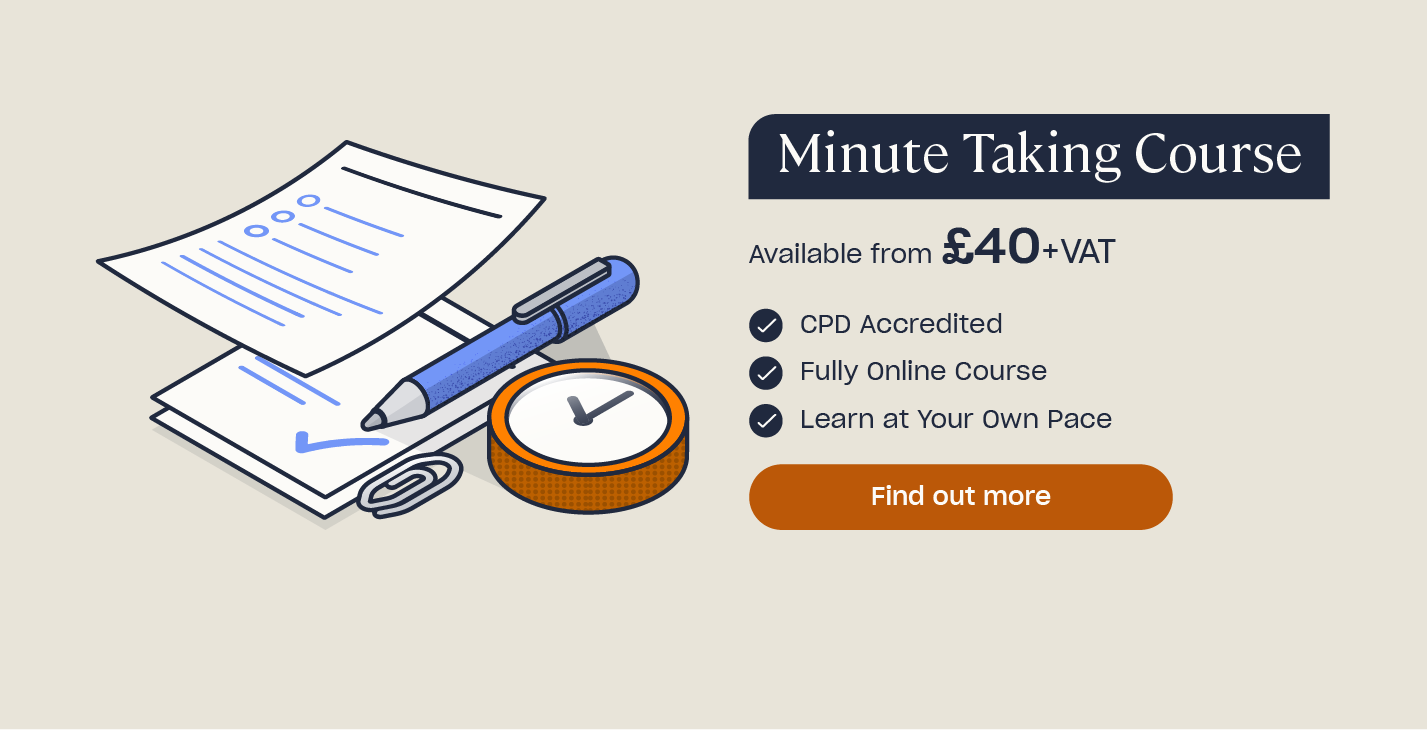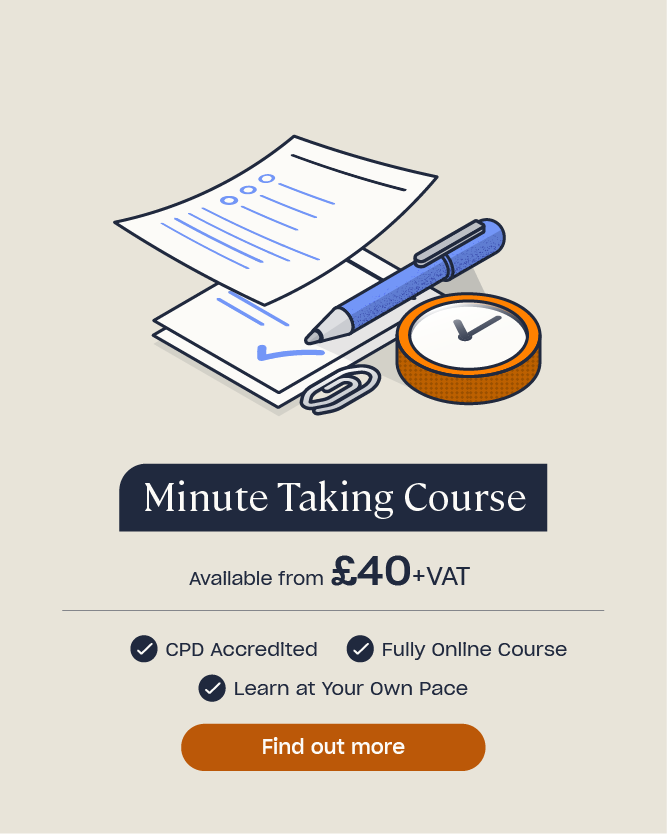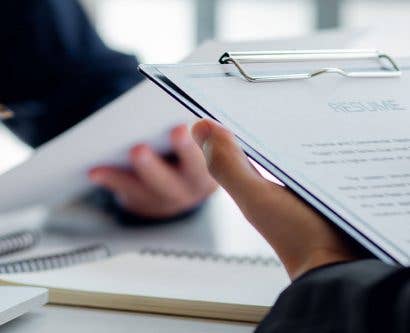How to Write Meeting Minutes: Free Template
Meetings are a frequent and important part of working life. They invite collaboration, encourage creative thinking and provide a platform for fruitful discussion. Writing meeting minutes are a key part of the success of a meeting as they record the points discussed and any actions to be taken. To be effective, meeting minutes must be clear, concise and provide a succinct record of the topics discussed.
In this article we will outline what meeting minutes are, why they are important and provide guidance on how to take useful meeting minutes. You will also find a downloadable template that you can use to effectively write meeting minutes.
What are Meeting Minutes?
Meeting minutes are a summary of the main points discussed by meeting attendees and the subsequent action points that they have decided upon. Meeting minutes are not a transcript of every single thing that was said during a meeting nor are they solely for formal meetings. Regardless of the type of meeting, meeting minutes serve as a record of the key elements discussed such as:
- Issues raised.
- Motions put forth.
- Decisions made.
- Actions agreed upon.
As a minute taker it is your responsibility to write clear and concise minutes that document the key talking points of the meeting. It is therefore beneficial to have a separate minute taker and Chairperson so that focus can be directed where necessary. An effective chairperson will ensure that meetings run smoothly and efficiently and that the agenda is followed accordingly. This enables you as the minute taker to focus solely on producing useful and succinct meeting minutes.

Why are Meeting Minutes Important?
Meeting minutes are an essential tool for before, during and after a meeting. They deliver key information and help to keep the necessary people informed of the main talking points of a meeting.
Meeting minutes are important because they:
- Help with meeting preparation – Minutes from previous meetings help organisers to prepare agendas for upcoming meetings. They provide information which can guide topics for discussion such as updating attendees on a project’s progress or reviewing the success of a previously agreed upon action.
- Act as an official record of proceedings – Meeting minutes act as an official record of discussions held, decisions made and actions taken. They act as a point of reference of what occurred during the meeting and can be easily referred back to by senior staff or stakeholders.
- Hold attendees accountable – Meeting minutes record actions that need to be taken and the person or department responsible for those actions. By documenting each task and associated action items, meeting minutes provide a clear indication of who is responsible for completing specific tasks.
- Build trust through transparency – Meeting minutes inform those not in attendance, whether due to absence or remote working, of the key points discussed. This provides important insight into the inner workings and discussions of meetings, highlighting to those not in attendance that attendees are acting in the best interest of the business.
- Improve efficiency – Well written meeting minutes provide information that can be used to guide future meetings. This saves times when reviewing prior decisions and actions and helps to eliminate repetitive discussions or tasks.
Looking for More?
Our Minute Taking Course will teach you the skills to produce clear and concise meeting minutes for any meeting. We also have a wide range of Business Essentials courses, such as our Communication Skills course, that will provide you with knowledge and skills to thrive in the workplace.
How to Take Minutes for a Meeting
Meeting minutes have to record a lot of different information, so it is important that they are as detailed and succinct as possible. Writing effective meeting minutes involves thorough preparation before the meeting, active listening during the meeting and diligent compilation after the meeting.

Here are five top tips to help you capture the essential information of any meeting, regardless of the size or formality.
- Be Prepared.
The better prepared you are for the meeting, the more efficiently you will be able to take notes. Take the time to find out the agenda points ahead of time so that you have an idea of what the meeting is about. If the meeting is a follow up, read over previous agenda points and minutes so that you have as much contextual knowledge as possible. Speak to the Chairperson in advance and ask for clarity on any points you are unsure of. Don’t forget to make sure you are physically prepared to take notes. It may seem obvious but make sure you have enough pens to hand and a notebook or paper with enough space to write the necessary information. If you prefer writing notes on your laptop, make sure your laptop is charged and muted to avoid any distractions from incoming notifications.
- Find your Focus.
It is important to know what you actually need to be making notes on so use the agenda to help determine the key topics of the meeting. As the minute taker you need to record information accurately as your notes will eventually serve as a reminder of the commitments made and topics discussed. It is important to get these details right and it is much easier to do this if you know in advance when to focus and when to just listen.
- Use a Template.
A template provides you with a clear structure with which to format your notes. It can help you to keep track of the important details and guide which information you decide to include based on pre-set subheadings/categories. Templates are also useful for maintaining consistency. Your business may have a set minute taker, or the role may change from meeting to meeting. However, a template ensures consistency irrespective of who is taking the minutes.
- Be Objective.
Only include the facts in your notes and remain neutral, avoiding any personal impressions or opinions. The finished meeting minutes must be an unbiased and impartial overview of the proceedings.
- Review your Minutes.
Once you have finished typing up your minutes and before distributing them to the necessary parties, have them reviewed and approved by the most senior person in attendance or the Chairperson. It is important to double check that the necessary information has been included and that dates, agreed actions and task assignees have been documented properly.

Due to the increase in hybrid/remote working, you may find yourself acting as minute taker for virtual meetings. The steps above remain applicable for remote meetings, however it is beneficial to also consider the following:
- Find a quiet space – Find a space where you won’t have any disruptions or distractions. If you’re working from home and others are present, let them know you have a meeting to attend and not to disturb you. It is important that you can clearly hear the other members of the meeting during a call, so reduce as much background noise as possible so that you can focus properly.
- Speak up – Remote meetings are frequently subjected to the whim of one’s internet connection. It’s highly likely that there will be drops in someone’s connection at some point during the meeting so it is important that you speak up to seek further clarity when necessary. Knowing how to speak up in meetings enables you to confidently ask attendees to repeat themselves and ensures that you do not miss any vital information.
- Record the meeting – The benefit of virtual meetings is the chance to record the entire thing. You must first ask permission from those attending or let them know well in advance that you will be recording the meeting. Recording the meeting allows you to be more present as you can then go back and watch over the recording to make any necessary notes.
- Use multiple screens – If you have more than one screen in your home office set up then make the most of the extra space. Having the meeting on one screen and a document for notes on the other, stops you from juggling multiple windows on the one screen and potentially missing key information as you switch from one window to another.
Meeting Minutes Template
Below you will find a meeting minutes template for you to download and use.
The template has been broken down into sections to help you prioritise key information such as the meeting objective, the agenda, main takeaways and action points. There is also space to include the meeting date, time, location and details of the next meeting. The template is fully editable so you can input additional information should you wish.
Being able to create clear, professional meeting minutes is a crucial skill to have as they are an important part of ensuring that meetings are productive and successful. As a minute taker it is your responsibility to produce useful notes in the final minutes document. Using the guidance and template above will help you to do just that and write effective meeting minutes.











